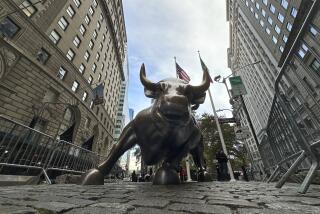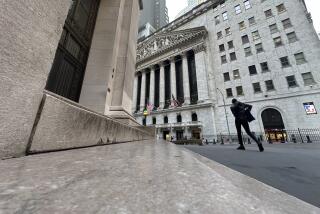For investors, a quarter to forget, if only we could
The reality of a debt-heavy global economy stuck in low gear hit home in the last three months, driving U.S. stocks to their worst quarterly loss since the 2008 financial crisis.
It would be a great quarter to just forget â if it didnât portend worse to come in the final months of the year.
Thatâs what investors are left to ponder as they count their losses: Does it make more sense to keep running for safety, as many did last quarter, or take advantage of what may turn out to be bargains in beaten-down stocks worldwide?
On Friday, share prices ended mostly lower around the globe, heaping more misery on equity investors battered by growing doubts about the economic outlook. The Dow Jones industrial average slumped 240.60 points, or 2.2%, to close the quarter at 10,913.38.
The 30-stock Dow lost 12.1% in the quarter. And that was pretty much the good news: The biggest stocks held up much better than the rest of the market.
The broader Standard & Poorâs 500 index, a benchmark for many 401(k) retirement accounts, fell 2.5% Friday and 14.3% for the quarter. It was the biggest decline since the index crashed 22.6% in the fourth quarter of 2008.
Market losses generally were worse overseas, particularly in Europe as the continentâs government-debt crisis raged on. The average European blue-chip stock tumbled 17.4% for the three months.
And in another blow to investor confidence, the asset many people had viewed as a haven â gold â was pummeled in the final few weeks of the quarter amid a steep decline in commodities. The yellow metal slid from nearly $1,900 an ounce in late August to end Friday at $1,620.
The two hiding places that actually lived up to that billing last quarter: cash and high-quality bonds, particularly U.S. government debt.
Yet with Treasury bond yields near generational lows, they arenât offering income-seeking investors much incentive to buy at this point.
Wall Streetâs remaining cadre of stock bulls argues that equities are cheap. And they may be right, if the bottom isnât about to fall out of the economy.
But trying to persuade average investors of that may be a losing battle. After all, thereâs no apparent resolution of the factors that made the third quarter so painful: the struggling U.S. economy, a downgrade of Americaâs credit rating, Europeâs unending debt crisis and new doubts about emerging economiesâ growth prospects.
Billionaire Warren Buffett, the perennial optimist, tried to send a hopeful message Monday when he announced that his Berkshire Hathaway Inc. holding company would begin buying back some of its own shares in the market â a move Buffett had resisted for decades. The companyâs underlying businesses âare worth considerably moreâ than the stock price, Berkshire said.
In TV interviews Friday, Buffett maintained his view that the U.S. economy was still expanding, though slowly.
The expectation that the U.S. can avoid another official recession is what has kept many institutional investors from rushing for the New York Stock Exchange exits, despite the third-quarter gloom. A late-August survey of big money managers nationwide by Russell Investments found that 79% didnât believe the U.S. economy was entering recession.
The publicâs opinion, however, is just the opposite: In a Harris Poll in September, 69% of Americans said the U.S. never climbed out of the last recession.
The evidence has been mixed for the last few months, but generally has pointed to weak growth. On Friday, however, the stock market was spooked by the governmentâs report that U.S. personal income fell 0.1% in August, the first decline in almost two years.
Americans still spent in August â personal spending rose 0.2% for the month â but the drop in income raises doubts about future consumption.
Thatâs setting up for another potentially wild market ride in October. Apart from whatever else goes wrong in Europe, more evidence of U.S. economic weakness could trigger a new selling wave in stocks. Better economic data, on the other hand, could bring a torrent of cash in from the sidelines, following the likes of Buffett.
âOnce you break either way, I think itâs going to be pretty dramatic,â said Bill Strazzullo, market strategist at Bell Curve Trading in Freehold, N.J.
Just what everyone was looking forward to: more insane volatility.
Strazzullo admits heâs puzzled that U.S. stocks have held up as well as they have. After diving in early August, the S&P 500 index has bounced between 1,120 and 1,220, a trading range of about 9%. And for what itâs worth, this still isnât technically a new bear market in blue chips: The S&P is down 17% from its two-year high reached in April, short of the 20% threshold that marks a bear.
But Strazzullo thinks itâs more likely the marketâs next move will be to plummet than to rebound. The S&P, he said, could fall another 15% or so before bottoming.
There are plenty of fast-moving pieces in the economy and markets now. For investors looking for reasons to sell, or buy, here are three key things to watch as the fourth quarter begins:
⢠Europeâs debt mess. This debacle has been going on almost two years, dating from the first indication that Greeceâs debt load had reached a level it could no longer afford. Similar fears have since engulfed Ireland and Portugal and now threaten the far larger economies of Spain and Italy.
The European Union is trying to halt the contagion once and for all via a $600-billion bailout fund known as the European Financial Stability Facility. The fund got an important endorsement this week when Germanyâs parliament voted to approve changes that would give the fund more flexibility to help cash-strapped member nations and their banks.
If financial markets believe that Europe finally is serious about ring-fencing its debt problems and devising an orderly way to deal with an inevitable Greek bond default, that should show up in stabilizing stock prices, particularly for the Eurozone banks that own massive amounts of government debt.
Ed Clissold, senior analyst at investment research firm Ned Davis Research in Atlanta, said the severe declines in European stocks in the third quarter made the shares much more interesting for long-term bargain hunters. âThere are a lot of fantastic global companies in Europe,â he said. But for now, buying them âis like catching a falling knife.â
⢠Corporate earnings. Third-quarter reports will begin to roll out in earnest the week of Oct. 10. Despite the economyâs struggles, Wall Street analysts have refused to give up on the idea of continuing profit growth, at least at the big-name S&P 500 companies.
Analysts expect overall growth in operating profit at the S&P companies to rise 13.3% in the third quarter year over year, according to estimates tracked by Thomson Reuters.
If companies beat expectations, as theyâve been doing for the last two years, that could help buttress stock prices. But because investors are supposed to look ahead, the key question on earnings may be what the market expects for 2012.
âThe equity market keeps focusing on current earnings. It should be focusing on future earnings,â said Steven Ricchiuto, chief economist at Mizuho Securities in New York.
If investors do that, he doesnât believe theyâll like what they see, given that continued high unemployment and political uncertainty (with the presidential election) are likely to weigh next year on U.S. consumer spending, which accounts for more than two-thirds of economic activity.
And if growth continues to slow overseas, that will make it harder for multinational firms to make up abroad for U.S. weakness.
Though U.S. stocks have fared better than the rest of the world this year, Ricchiuto thinks itâs more likely that âthe U.S. market goes down to meet the rest of the worldâ from here, rather than that foreign stocks come up.
⢠Commodity prices. The plunge in prices of many raw materials over the last month has further unnerved investors already shaken by the sell-off in stocks. The ThomsonReuters/Jefferies CRB index of 19 major commodities tumbled almost 12% in the third quarter, including a 2.6% drop Friday to the lowest level since November.
U.S. crude oil slid $2.94 to $79.20 a barrel Friday, a new 52-week low. In the near term, at least, thatâs a positive for consumers.
Some of the decline in commodities last quarter stemmed from the need by hedge funds and other big investors to quickly raise cash amid the market turmoil, analysts say. âSelling winners to pay for losers has been a big part of it,â said William OâNeill, a veteran commodity trader at Logic Advisors in Upper Saddle River, N.J.
But commodity investors also fear that slowing growth in China, in particular, is clipping the appetite for raw materials. A gauge of Chinese manufacturing activity contracted in September for a third month.
If commoditiesâ slide continues in October, signaling waning demand worldwide, the stock market is almost certain to see it as another sign that recession risks are rising.
More to Read
Inside the business of entertainment
The Wide Shot brings you news, analysis and insights on everything from streaming wars to production â and what it all means for the future.
You may occasionally receive promotional content from the Los Angeles Times.








